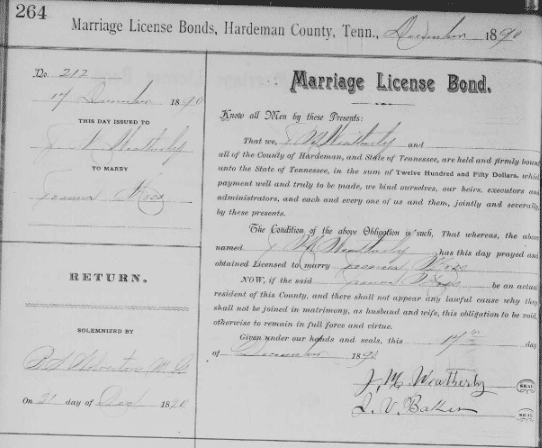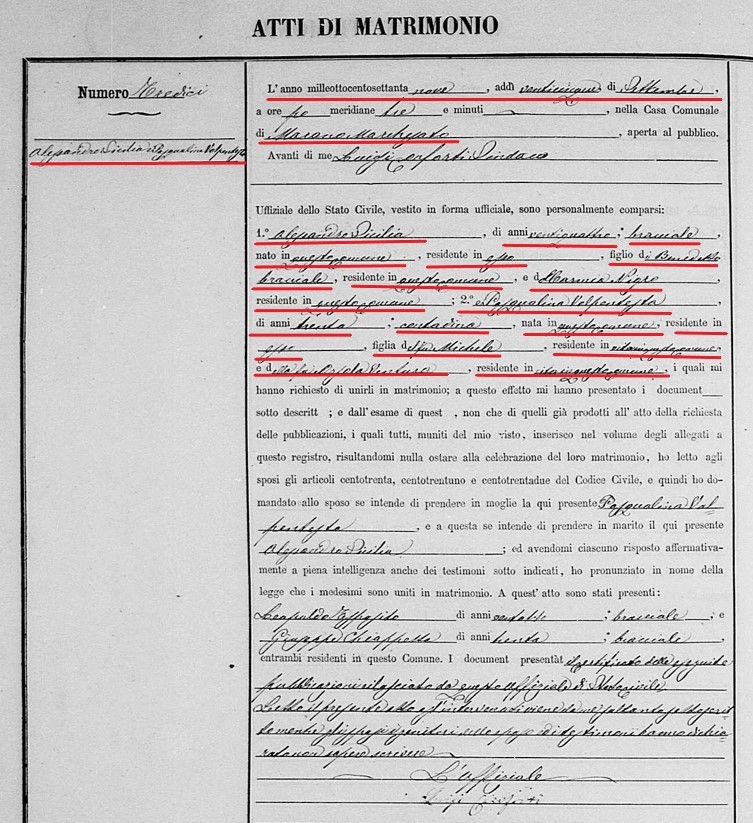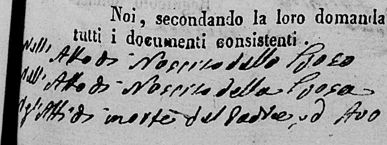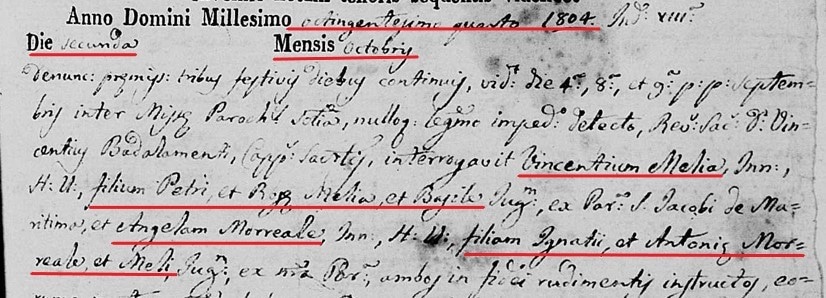Romantic Italian Weddings – Why Research Italian Marriage Records?
 17
17Feb

Traditional Italian weddings take years to plan and prepare for as it is customary for the couple to not only prepare for the wedding ceremony and reception, but in addition, purchase their home and furnish it before the wedding date. Weddings range in size from small to large, but in Italy, the tradition is to invite everyone! Immediate family, all extended family, friends, business acquaintances, dignitaries, religious connections and leaders – everyone. This is not a small investment, and the couple and their families devote years to fully prepare and pay for this event.
Italian weddings are not held on Fridays as it is believed that evil spirits are created on that day and it may bring you bad luck. Having good luck for your wedding is a serious matter, so the bride will make a small tear in her wedding veil and groom will carry an iron token in his pocket for months ahead of the day to bring extra luck. Rice is showered on the bride and groom as they leave to promote good spirits in their home and fertility for the couple. The wedding favors are typically sweet almond candies in a little bag with exactly five or seven pieces of paper streamers inside. Those specific numbers signify good luck!
How to Search for Italian Marriage Records
When doing Italian research, we oftentimes need a great deal of luck as well. Many villages are not yet available to search online at the Antenati.San.Beneculturali.it website or the FamilySearch.org website. At times there are significant holes or missing groups of years, even when records are published and available to search. Having lived through several wars, Italian parishes have lost records in fires, floods and even earthquakes.
When we are lucky and we find records open to search, we often begin by looking for the birth records and death records of our ancestors which will help us either discover who the parents were, or verify we have the correct parents in our personal records.
What about a marriage record? Why would one take time to find and research the marriage record? What information can be gleaned there? Often in the United States the marriage record will only list the Groom and Bride and that they married on a particular date, and where. Take a look at my great-grandfather’s Marriage Bond Record[i] – very little information is discovered:

This Marriage Bond was created 17 Dec 1890 and the marriage was solemnized on 21 Dec 1890. It gives the names of the bride and groom, JM Weatherly and Joanna Moss and that they both reside in Hardeman County, Tennessee. No parents, no city of birth information, or even the city they are currently living in – only the county. Not even a full name for the groom, which has caused significant issues in further verification and research for this pedigree.
In European marriages many more vital facts are usually recorded, and that is enormously useful for those of us researching these records today. In Italian marriage records, the following important facts are typically unveiled:
- The village of birth for the groom.
- The village the groom is currently living in at the time of marriage.
- The occupation of the groom.
- The name of the groom’s father, and whether he is living or deceased.
- The village in which the groom’s father is currently living.
- The occupation of the groom’s father.
- The name of the groom’s mother, and whether she is living or deceased.
- The village in which the groom’s mother is living.
- On occasion, the occupation of the groom’s mother.
- Likewise, all nine of the above items for the bride and her parents.
- If a parent is deceased at the time of the marriage, the priest will often notate the date of that parent’s death.
- That death notation will often list the father of that deceased parent, which would reveal the grandfather’s name.
- Marriage records from the southern parts of Italy often include additional certified documents of the bride and groom’s births, which provides secondary evidence of those birth dates and of the parents’ names.
- If the bride and groom were previously married and are now widowed, it will list the previous spouse, ofttimes adding the father’s name of that deceased spouse and the date of that death.
This brings 22-28 points of information to light and gained from one single marriage record!
Here is an example of a marriage record[ii] from the village of Marano Marchesato in 1879:

From this document, we uncover the following Italian Marriage Records vital information:
- Date of this marriage – 29 September 1789
- City that this marriage occurred in – Marano Marchesato
- Name of the groom – Alessandro Sicilia
- Groom’s age – 24
- Groom’s occupation – bracciale (day laborer)
- Village of birth – questo comune (this village – Marano Marchesato)
- Village residing in – esso (living in it – Marano Marchesato)
- The son of Benedetto, who is currently alive
- Benedetto’s occupation is a bracciale
- Benedetto is residing in questo comune – Marano Marchesato
- Mother of the groom is Marania Nigro, she is living
- She a resident of this village
- Name of the bride – Pasqualina Valpentesta
- Bride’s age – 30
- Bride’s occupation – contadina (peasant)
- She was born in this village – Marano Marchesato
- She is residing in this village
- Pasqualina is fu Michele (daughter of the late Michele - he has passed away)
- Michele, when living, resided in this village – Marano Marchesato
- Bride is fu Orsola Ventura (daughter of the late – the mother has also passed away)
- Orsola, when living, resided in this same village.
In some areas of Italy, particularly in the southern regions, additional information may be included. These marriage records will be five to twelve separate pages in length, rather than one universal form filled out as seen above.
In this example of a Marriage Act[iii] in Sicily, at the bottom of the second page, it lists that other documents will be included – the Birth Act of the Groom, the Birth Act of the Bride and the Death Act of the father of the Bride:

Those additional documents will provide secondary evidence of the parents’ names of both the bride and groom, and give new information – the death information of the father of the bride – Vincenzo Melia, married to Angela, died 28 September 1820:

This Sicilian Marriage Act also included a bonus document – the Marriage Act of these parents of the bride – Vincenzo Melia and Angela Morreale. The document helped us discover important new facts – the paternal and maternal grandparents’ names of the bride, and the marriage date:

- Marriage date – 2 October 1804
- Parents of Vincenzo – Pietro Melia and Rosa Basile
- Parents of Angela – Ignazio Morreale and Antonia Meli
This is why one should actively seek after Italian Marriage Records – they provide so many valuable gems in their pages!
In modern Italy, a great deal of time and focus often revolves around the ceremony and the reception preparations, including their wonderful superstitions, however, Italians are careful to include all proper documentation establishing the bride and groom are free to marry. Public notices are posted in their home villages, either on the city office doors or on the local church doors to give everyone in the village an opportunity to bring any reason forward that they cannot wed. The couple must register an Intention to Marry in the city office and then the city will publish two notifications that need to be visible for eight days, which must include two Sundays. The city will then provide a certificate attesting that the publication is complete and there are no impediments to the marriage. Typically, the couple will happily marry within a week of that certificate date.
These important Italian marriage records provide invaluable information that could open up several generations of data which will assist you in enlarging your Italian family pedigree. Buona fortuna!
Pam
[i] Tennessee, County Marriages, 1790-1950, “Tennessee Marriages, 1796-1950," database, FamilySearch (https://familysearch.org/ark:/61903/1:1:XDSJ-N6G : 16 March 2020), J. M. Weatherly, 1890.
[ii] Italia, Cosenza, Marano Marchesato, Ufficio dello State Civile, “Registro dello stato civile di Marana Marchesato (Cosenza), 1809-1910,” FamilySearch (www.familysearch.org : accessed Oct 2021), FHL International Film #1641041, Items 1-3, Alessandro Sicilia and Pasqualina Valpentesta Marriage Act #13.
[iii] Italia, Palermo, Santa Ninfa, Ufficio dello stato civile, “Registro dello stato civile di Palermo (Palermo), 1820-1908,” FamilySearch (www.familysearch.org: accessed Dec 2019), FHL International Film #,1442217, Ignazio D’Accardi and Antonina Milia Marriage Act #93, Pages 1-11.
